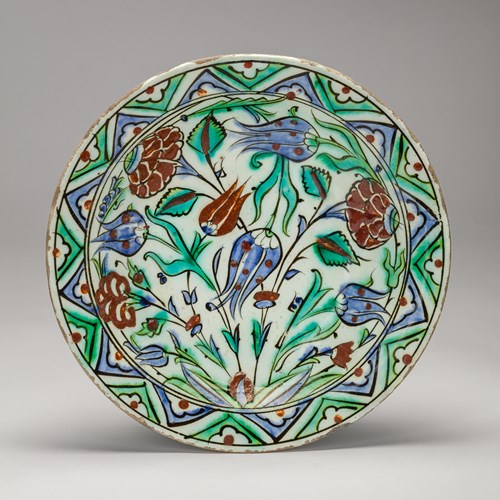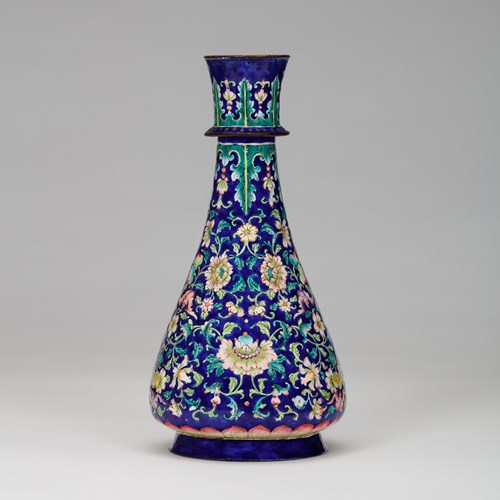Marketplace
Enamelled Spice Box
Spice boxes appear in Mughal miniatures, from the late 16th century onwards (see accession no. 1999,1202,0.5.2 in the British Museum, London). The individual compartments of this box would have been used for storing chopped betel nuts, mixed spices, slaked lime, tobacco, and betel leaves, which the heart-shaped lids of this box resemble.
Of silver-gilt, enamelled in blue, green, and red, the ornamentation of this spice box closely resembles the renowned champlevé and basse-taille enamelware made in 18th century Lucknow, in the state of Uttar Pradesh. When the central knop, itself resembling a vase of flowers, is unscrewed and removed, each of the heart-shaped lids is free to open. An ogival pandan in the collection of the Los Angeles County Museum of Art (accession no. AC1993.137.1.1-2) has similarly brightly coloured floral sprays, and mostly notably, both have two birds with maroon bodies and blue wings standing aspectant.
A significant part of Lucknow’s vegetal imagery was the acanthus leaf, a decorative motif originating in Corinthian capitals around 9000 years ago, which assimilated into Asian art.1 The acanthus bract, pairs of leaves branching from a stalk, can be seen throughout this spice box. Similar use of this motif is seen on a tray made in Lucknow in the LA Country Museum (accession no. M.76.2.27a-L). The underside of the box is decorated with a large floral rosette, inside an ornamental cartouche formed from split acanthus leaves.
A silver enamelled spice box of similar form and ornamentation, originating from mid-19th century Lucknow, can be found in the collection of the V&A (accession no. 131-1852). This form takes inspiration from Rajasthani prototypes, such as those on pages 158-161 of Mughal Silver Magnificence.2
n.b. accession nos are clickable links
1 Markel, Stephen. India’s Fabled City: The Art of Courtly Lucknow. Los Angeles: DelMonico Books and Los Angeles County Museum of Art, 2010.
2 Terlinden, Christiane et al. Mughal Silver Magnificence (XVI-XIXth C)/ Magnificence de l’Argenterie Moghole (XVI-XIXème S.). Geneva: Antalga for the Museum of Art and History of Geneva, 1987.
Of silver-gilt, enamelled in blue, green, and red, the ornamentation of this spice box closely resembles the renowned champlevé and basse-taille enamelware made in 18th century Lucknow, in the state of Uttar Pradesh. When the central knop, itself resembling a vase of flowers, is unscrewed and removed, each of the heart-shaped lids is free to open. An ogival pandan in the collection of the Los Angeles County Museum of Art (accession no. AC1993.137.1.1-2) has similarly brightly coloured floral sprays, and mostly notably, both have two birds with maroon bodies and blue wings standing aspectant.
A significant part of Lucknow’s vegetal imagery was the acanthus leaf, a decorative motif originating in Corinthian capitals around 9000 years ago, which assimilated into Asian art.1 The acanthus bract, pairs of leaves branching from a stalk, can be seen throughout this spice box. Similar use of this motif is seen on a tray made in Lucknow in the LA Country Museum (accession no. M.76.2.27a-L). The underside of the box is decorated with a large floral rosette, inside an ornamental cartouche formed from split acanthus leaves.
A silver enamelled spice box of similar form and ornamentation, originating from mid-19th century Lucknow, can be found in the collection of the V&A (accession no. 131-1852). This form takes inspiration from Rajasthani prototypes, such as those on pages 158-161 of Mughal Silver Magnificence.2
n.b. accession nos are clickable links
1 Markel, Stephen. India’s Fabled City: The Art of Courtly Lucknow. Los Angeles: DelMonico Books and Los Angeles County Museum of Art, 2010.
2 Terlinden, Christiane et al. Mughal Silver Magnificence (XVI-XIXth C)/ Magnificence de l’Argenterie Moghole (XVI-XIXème S.). Geneva: Antalga for the Museum of Art and History of Geneva, 1987.
More artworks from the Gallery







_T638563782373054250.jpg?width=500&height=500&mode=pad&scale=both&qlt=90&format=jpg)

